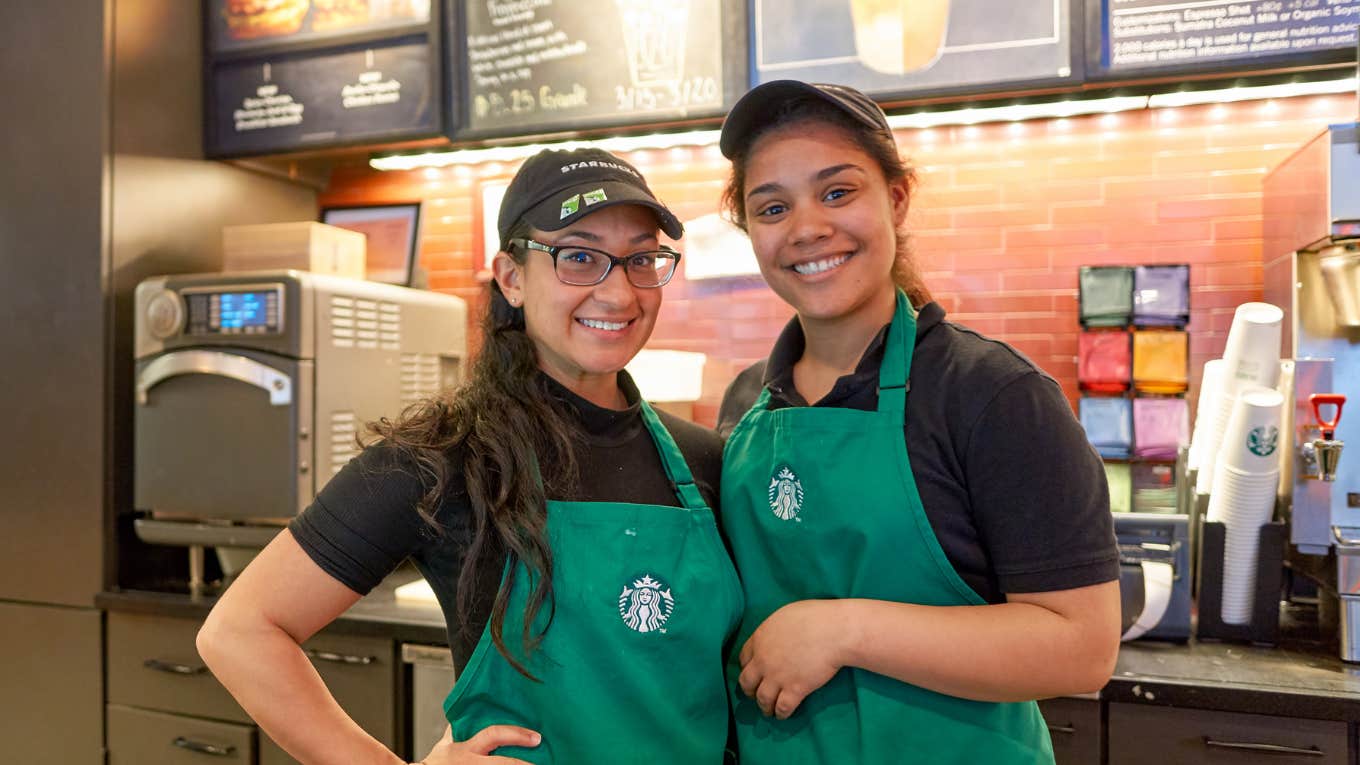Why Starbucks Workers Are Striking Over Its New Dress Code Requiring Staff To Wear Plain Black Shirts
Is it fair to require workers to buy an entire new wardrobe… to make coffee?
 Sorbis | Shutterstock
Sorbis | Shutterstock More than 1,200 Starbucks employees represented by the Starbucks Workers United labor union have gone on strike over changes to uniform standards that workers say are a distraction from bigger problems at the coffee chain. But the company's management says the workers are so well paid they have no reason to complain.
Why Starbucks workers are striking over the company's new dress code.
Representatives from the Starbucks Workers United union say walk-outs have taken place at more than 100 Starbucks locations nationwide following a new dress code implemented by the company that began May 12.
The dress code requires workers to wear plain black shirts, along with black, khaki, or dark denim pants. In a press release, the company said the change was to "allow our iconic green apron to shine and create a sense of familiarity for our customers."
Brand recognition is not exactly a problem for Starbucks, a company so ubiquitous worldwide that it has been the butt of jokes about it for decades. Workers say it is causing all kinds of logistical problems for them, while ignoring more pressing concerns, all for a dress code that Starbucks enacted with no input from its workers' union.
Starbucks employees say the dress code creates an unfair expense as workers now have to buy new clothes.
Part of the new dress code includes two free black t-shirts provided by the company as part of the aim toward a "more defined color palette." But two shirts aren't nearly enough for an entire five-day work week, of course, forcing many employees to purchase a new wardrobe for their job.
At first blush, it seems a bit petty. We're talking about buying a few t-shirts, right? But Starbucks workers' advocates point out that employees already have a whole collection of t-shirts they were forced by the company to purchase in previous years, which they will now no longer be allowed to wear.
The company also changed its dress code back in 2016 in the complete opposite direction, urging employees to dress uniquely, allowing looks like pink hair and bold hats, in an effort to go beyond the "black/white tops with khaki pants under a green apron" look they are now enforcing.
Workers also say the dress code is a 'distraction' from bigger issues at Starbucks.
The dress code change is part of a wider strategy at the company called "Back To Starbucks," a title that implies the company has lost its way. Indeed, Starbucks sales have been declining for the last four quarters in a row.
The "Back to Starbucks" plan, which includes eliminating menu items as well as the new dress code, is CEO Brian Niccol's bid to boost sales, better serve customers, and refocus on "those things that have always set us apart." In a recent shareholder meeting, he said the dress code will help "ensure our coffeehouses have the right vibe," whatever that means.
But workers and union reps say the entire strategy is a distraction from the real issues: widespread problems with understaffing that have lengthened service times and related problems with working conditions that the company refuses to address.
The new dress code, they say, has added to these issues. Jasmine Leli, a union delegate and barista from Buffalo, New York, told USA Today that workers keep getting sent home "because the manager's interpretation of the color of jeans that they're wearing doesn't fit the dress code." Others have noted that many of these violations have stemmed from the shirts provided by Starbucks never arriving due to website errors.
"The floors are not properly staffed as it is," Leli went on to say. "All the customer is concerned about is getting their drinks and going about their merry way. They don't care what color shirt we have on."
Starbucks has responded by blaming workers and implying they shouldn't complain because they are highly paid.
As far as foodservice jobs go, Starbucks is one of the better-paying gigs. Analysis by Indeed found that the average wage at U.S. Starbucks locations is just over $15 an hour, and the company has become famous for offering benefits like healthcare to its staff.
In a pointed statement to USA Today, the company implied that its workers are being ungrateful by protesting against the changes. "While the union is focused on a simplified dress code, we’re focused on providing the best job in retail with a wage and benefits package that averages more than $30 per hour for hourly partners," the company wrote. "It would be more productive if the union would put the same effort into coming back to the table to finalize a reasonable contract."
But union reps counter that the changes came out of nowhere in the midst of those negotiations, without any consultation from the union, a situation that has resulted in them filing a formal complaint in April with the US National Labor Relations Board.
Paige Summers, a Starbucks supervisor from Maryland, told USA Today that some of her staff are unable to afford the new wardrobe they must buy for the new dress code, and held up the situation as an example of how the company doesn't listen to its employees or its customers.
"Starbucks has lost its way. Instead of listening to baristas who make the Starbucks experience what it is, they are focused on all the wrong things," Summers said in a statement shared by Workers United. "Customers don’t care what color our clothes are when they’re waiting 30 minutes for a latte." Hard to argue with that.
John Sundholm is a writer, editor, and video personality with 20 years of experience in media and entertainment. He covers culture, mental health, and human interest topics.

